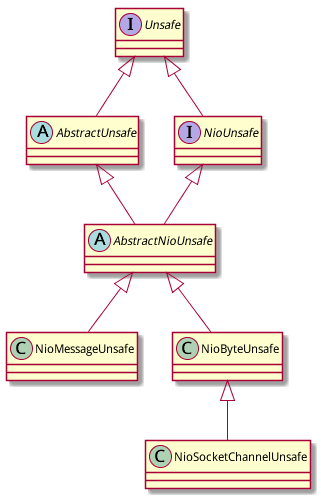前面谈到在Channel接口内部定义了一个Unsafe接口, 然后有部分方法是直接delagate给unsafe的:
public boolean isWritable() {
ChannelOutboundBuffer buf = unsafe.outboundBuffer();
return buf != null && buf.isWritable();
}
Unsafe的概念
Unsafe 是内部接口, 从设计上说这个接口的所有实现都是netty的内部代码,只能被netty自己使用. netty的使用者时不应该 直接调用这些内部实现的.
Unsafe的javadoc是这样要求的:
Unsafe operations that should never be called from user-code. These methods are only provided to implement the actual transport, and must be invoked from an I/O thread except for the following methods:
Unsafe 操作不能被用户代码调用.这些方法仅仅用于实现具体的transport, 而且必须被I/O线程调用.
以下方法例外(可以在I/O线程之外被调用):
- invoker()
- localAddress()
- remoteAddress()
- closeForcibly()
- register(EventLoop, ChannelPromise)
- deregister(ChannelPromise)
- voidPromise()
Unsafe 接口定义
Unsafe定义的方法
Unsafe接口中定义了以下方法:
获取特殊属性
- RecvByteBufAllocator.Handle recvBufAllocHandle()
- ChannelHandlerInvoker invoker()
- ChannelOutboundBuffer outboundBuffer()
- ChannelPromise voidPromise()
获取网络参数
- SocketAddress localAddress()
- SocketAddress remoteAddress()
注册到EventLoop
- void register(EventLoop eventLoop, ChannelPromise promise)
- void deregister(ChannelPromise promise)
IO操作
- void bind(SocketAddress localAddress, ChannelPromise promise)
- void connect(SocketAddress remoteAddress, SocketAddress localAddress, ChannelPromise promise)
- void disconnect(ChannelPromise promise)
- void close(ChannelPromise promise)
- void closeForcibly()
- void beginRead()
- void write(Object msg, ChannelPromise promise)
- void flush()
Unsafe的实现
Unsafe的继承结构
以nio unsafe为例:

AbstractUnsafe
在AbstractChannel中定义有内部类AbstractUnsafe, 按照javadoc的说明, 所有的Unsafe的实现都必须从AbstractUnsafe继承:
public abstract class AbstractChannel extends DefaultAttributeMap implements Channel {
/**
* {@link Unsafe} implementation which sub-classes must extend and use.
*/
protected abstract class AbstractUnsafe implements Unsafe {
}
}